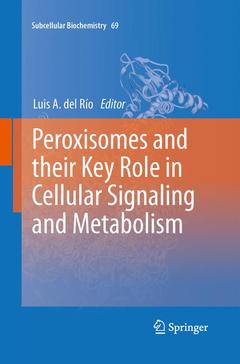Description
Peroxisomes and their Key Role in Cellular Signaling and Metabolism, Softcover reprint of the original 1st ed. 2013
Subcellular Biochemistry Series, Vol. 69
Language: English
Subjects for Peroxisomes and their Key Role in Cellular Signaling and...:
Publication date: 08-2015
Support: Print on demand
Publication date: 07-2013
350 p. · 15.5x23.5 cm · Hardback
Description
/li>Contents
/li>Comment
/li>
Dedication
Preface
1. Peroxisome interactions and cross-talk with other subcellular compartments in animal cells; Michael Schrader, Sandra Grille, H. Dariush Fahimiand Markus Islinger
2. Peroxisomes in human health and disease: metabolic pathways, metabolite transport, interplay with other organelles and signal transduction; Ronald J.A. Wanders
3. Aging, age-related diseases and peroxisomes; Marc Fransen, Marcus Nordgren, Bo Wang, Oksana Apanasets and Paul P. Van Veldhoven
4. Peroxisomes and the antiviral responses of mammalian cells; Charlotte Odendall and Jonathan C. Kagan
5. Peroxisome proliferator-activated receptor-α signaling in hepatocarcinogenesis; Parimal Misra, Navin Viswakarmaand Janardan K. Reddy
6. Involvement of human peroxisomes in biosynthesis and signaling of steroid and peptide hormones; Isabelle Weinhofer, Markus Kunze, Sonja Forss-Petterand Johannes Berger
7. Peroxisome Ca2+ homeostasis in animal and plant cells; Alex Costa, Ilaria Drago, Michela Zottini, Paola Pizzoand Tullio Pozzan
8. The versatility of peroxisome function in filamentous fungi; Ida J. van der Kleiand Marten Veenhuis
9. Essential roles of peroxisomally produced and metabolized biomolecules in regulating yeast longevity; Adam Beachand Vladimir I. Titorenko
10. Metabolite transporters of the plant peroxisomal membrane - known and unknown; Nicole Linkaand Frederica L. Theodoulou
11. Peroxisomes and photomorphogenesis; Navneet Kaur, Jiying Li, and Jianping Hu
12. Biosynthesis of vitamin K1 (phylloquinone) by plant peroxisomes and its integration into signaling molecule synthesis pathways; Sigrun Reumann
13. Role of peroxisomes as a source of reactive oxygen species (ROS) signaling molecules; Luisa M. Sandalio, María Rodríguez-Serrano, María C. Romero-Puertas and Luis A. del Río
14. Peroxisomes as a source of auxin signaling molecules; Gretchen M. Spiess and Bethany K. Zolman
15. Peroxisomes as cell generators of reactive nitrogen species (RNS) signal molecules; Francisco J. Corpas, Juan B. Barroso, José M Palmaand Luis A. del Río
16. Role of plant peroxisomes in the production of jasmonic acid-based signals;José León17. Role of plant peroxisomes in protection against herbivores; Mohammed Shabab
18. Function of Peroxisomes in Plant-Pathogen Interactions; Yasuyuki Kubo
Index
Describes the central role played in cellular signaling by peroxisomes from different origins
Provides an up-to-date information on the function and metabolism of peroxisomes from human, animal, fungal and plant origin
Provides updated information on the metabolic interconnection and cross-talk of peroxisomes with other cell compartments
Describes the key cellular function played by peroxisomes as cell generators of important signaling molecules
Covers the role played by peroxisomes in human health, aging and disease




